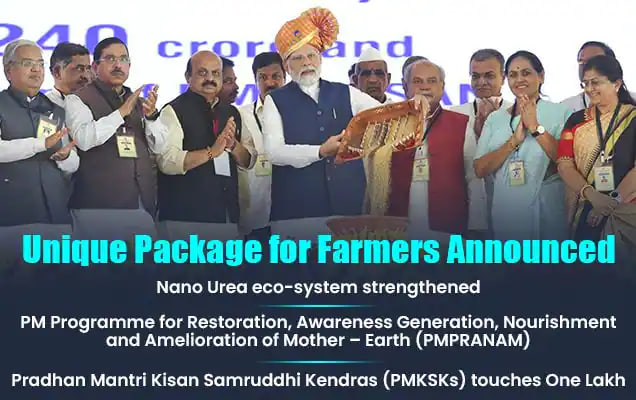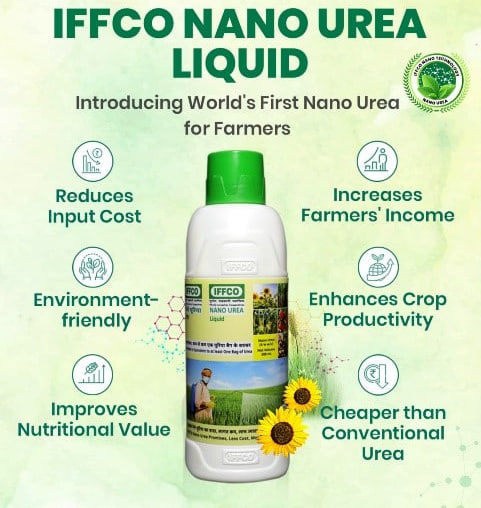Description

Copyright infringement not intended
Context: The government has announced a unique package for farmers that aim to improve their well-being, soil productivity, food security and environmental sustainability. The Cabinet Committee on Economic Affairs (CCEA) has approved a collection of programmes aims to improve farmers' overall well-being and economic well-being by encouraging sustainable agriculture.

Programmes covered under the Package
- Strengthen Nano Urea eco-system
- Atmanirbhar in Urea by 2025-26
- PM Programme for Restoration, Awareness Generation, Nourishment and Amelioration of Mother – Earth (PMPRANAM)
- Market Development Assistance (MDA) for promoting Organic Fertilizers from Gobardhan Plants.
- Introduction of Sulphur coated Urea (Urea Gold); to address the sulphur deficiency of soil and save input costs for the farmers.
- Pradhan Mantri Kisan Samruddhi Kendras (PMKSKs)
Strengthen the Nano Urea ecosystem
- The Government of India has announced the continuation of the Urea Subsidy Scheme for three more years, from 2022-23 to 2024-25. This scheme aims to ensure the availability of urea to the farmers at a subsidized price of Rs 242 per 45 kg bag, excluding taxes and neem coating charges.
- The total subsidy package for this period is Rs 3,68,676.7 Crore, in addition to the Nutrient Based Subsidy of Rs 38,000 Crore for the Kharif season of 2023-24. This will help the farmers to reduce their input costs and maintain their profitability.
- The Urea Subsidy Scheme is fully funded by the Government of India through budgetary support.
- The scheme is part of the government's efforts to promote the indigenous production of urea and achieve self-reliance in this sector.

Atmanirbhar in Urea by 2025-26
- India is on track to achieve self-reliance in urea production by 2025-26, due to the establishment and revival of six urea plants across the country since 2018. These plants are located in;
- Kota, Rajasthan
- Panagarh, West Bengal
- Ramagundam in Telangana
- Gorakhpur in Uttar Pradesh
- Sindri in Jharkhand
- Barauni in Bihar
- The domestic production of urea has risen from 225 lakh metric tonnes (LMT) in 2014-15 to 250 LMT in 2021-22. The production capacity is expected to reach 284 LMT in 2022-23.
- The introduction of Nano Urea Plants will further reduce the dependence on urea imports and make India self-sufficient by 2025-26.
- Nano Urea Plant is a new technology that produces urea in liquid form using nanoparticles, which reduces the consumption and cost of urea and enhances its efficiency and environmental benefits.
PMPRANAM
- It is an initiative that aims to protect and enhance the fertility of the soil, which is the foundation of food security and livelihoods.
- It encourages and supports the adoption of natural/organic farming, alternate fertilizers, and innovations like Nano Fertilizers and bio-Fertilizers, which can reduce the dependency on chemical fertilizers and improve soil health.
- It creates awareness among farmers and consumers about the benefits of natural/organic farming and products and the adverse effects of excessive use of chemical fertilizers on the environment and human health.
- It provides incentives to States/ Union Territories based on their performance in promoting alternate fertilizers and balanced use of chemical fertilizers.
- It is implemented in collaboration with various stakeholders, such as State Governments, research institutions, civil society organizations, the private sector, etc.
Market Development Assistance (MDA)
- The government has taken a major step towards promoting organic fertilizers from Gobardhan Plants by approving the Rs. 1451.84 crores for Market Development Assistance (MDA) scheme.
- This scheme will provide Rs 1500 per MT to the producers of Fermented Organic Manures (FOM), Liquid FOM and Phosphate Rich Organic Manures (PROM) that are derived from Bio-gas Plants or Compressed Biogas (CBG) Plants under the GOBARdhan initiative.
- These organic fertilizers will be marketed under the Bharat Brand name and will offer multiple benefits to the farmers and the environment.
- They will help in managing crop residue, reducing Parali burning, enhancing soil health, and generating additional income for farmers. They will also be available at affordable prices for the farmers.
- The MDA scheme is part of the Budget announcement of setting up 500 new waste-to-wealth plants under the GOBARdhan scheme, which aims to promote a circular economy and reduce greenhouse gas emissions.
Sulphur-coated Urea (Urea Gold)
- One of the key components of the package is the introduction of Sulphur coated Urea (Urea Gold) in the country for the first time. This is a superior alternative to the Neem coated urea that is currently used.
- Sulphur coated Urea (Urea Gold) is a fertilizer that has a thin layer of Sulphur on each granule of urea. This layer prevents the urea from dissolving quickly in water and thus reduces the loss of nitrogen due to leaching and volatilization.
- This means that less urea is needed to provide the same amount of nitrogen to the crops, which saves money for the farmers and also reduces the environmental impact of excess nitrogen.
- It provides Sulphur to the soil, which is an essential nutrient for many crops, especially oilseeds and pulses. Sulphur deficiency is a common problem in Indian soils, which affects crop quality and yield. By using Sulphur coated Urea (Urea Gold), the farmers can address this problem and improve their crop production and income.
Pradhan Mantri Kisan Samruddhi Kendras (PMKSKs)
- They are a network of one lakh centres across the country that offers farm inputs to farmers in a convenient and integrated manner.
- These centres provide a one-stop solution for all the needs of farmers, such as seeds, fertilizers, pesticides, farm machinery, credit, insurance and market linkages.
- It will also create awareness and educate farmers about the benefits of natural farming and soil conservation.

Benefits of these schemes
- They will help farmers save on input costs by providing them with affordable and effective fertilizers that can enhance crop growth and yield.
- They will help improve soil quality and fertility by reducing the overuse and misuse of chemical fertilizers, which can cause soil degradation and nutrient imbalance.
- They will help protect the environment by reducing soil and water pollution, greenhouse gas emissions, and crop residue burning, which can adversely affect air quality and human health.
- They will help promote natural and organic farming practices, which can preserve biodiversity, conserve natural resources, and ensure food safety and security.
Conclusion
- The government is committed to supporting farmers and ensuring their welfare through these schemes. Farmers can avail of these schemes by applying through the designated channels and following the prescribed guidelines. The government will also provide training, awareness, and extension services to farmers to help them adopt these schemes effectively. By using organic and alternative fertilizers, farmers can not only improve their income and livelihoods but also contribute to the noble cause of restoring and nourishing Mother Earth.
Must Read
Nano Urea: https://www.iasgyan.in/daily-current-affairs/nano-urea-49
PM PRANAM: https://www.iasgyan.in/daily-current-affairs/pm-pranam-scheme
Pradhan Mantri Kisan Samruddhi Kendras: https://www.iasgyan.in/daily-current-affairs/pradhan-mantri-kisan-samruddhi-kendras
|
PRACTICE QUESTION
Q. One of the major challenges in sustainable agriculture practices is how to balance the demand for food production with the environmental and social impacts of chemical fertilizers. What are the benefits and challenges of using alternate fertilizers, such as nano-fertilizers and bio-fertilizers that can enhance soil health and crop quality without harming the ecosystem?
|
https://pib.gov.in/PressReleasePage.aspx?PRID=1935896















